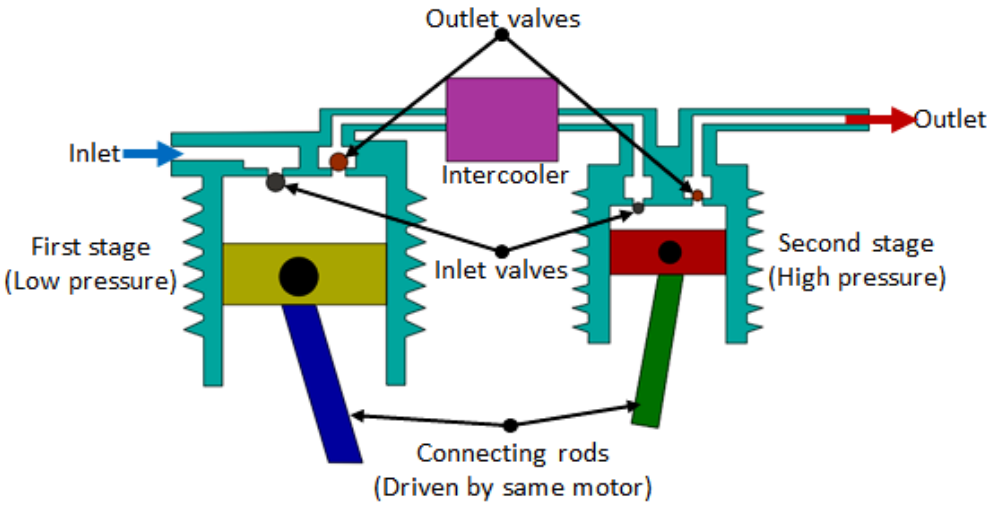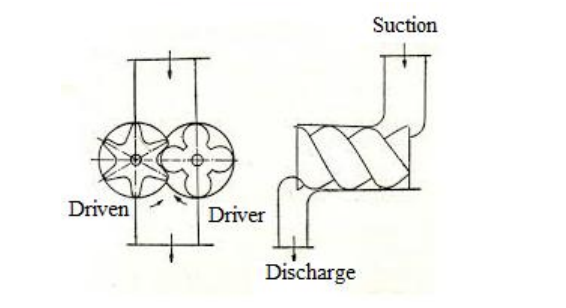Q.1. Classify air compressors.
Ans : Basically, compressors are of two types,
Positive displacement air compressors,
in which the pressure in the air is induced by mechanically reducing its volume.
Dynamic type air compressors, in which the pressure in the air is induced by dynamic effect, i.e., imparting motion to air and later converting velocity into static
pressure. Various types of air compressors Further, the air compressors can be classified on different basis as follows,
By portability: as portable compressor, stationary compressors.
By drive: e.g. diesel engine driven, motor driven etc.
By stages of operation: e.g. single stage, double stage etc.
By geometry of cylinder arrangement: e.g. vertical, horizontal, V-type etc.

Q.2. Explain with sketch single acting single stage reciprocating air compressor.

Ans: Piston compressors are commonly used in pneumatic systems. The simplest form is single cylinder compressor shown in figure. It produces one pulse of air per piston stroke. As the piston moves down during the inlet stroke the inlet valve opens and air is drawn into the cylinder. As the piston moves up the inlet valve closes and the exhaust valve opens which allows the air to be expelled. The valves are spring loaded. The single cylinder compressor gives significant amount of pressure pulses at the outlet port. The pressure developed is about 3-40 bar. The main limitation of this compressor is that it supplies the pulsating air. Further if more pressure is required it goes on becoming more bulky in size.
Q.3. Explain with sketch Double acting single stage reciprocating air compressor.
Ans: Double acting reciprocating air compressor is similar to double acting reciprocating pump. It iscomprised of following parts:
1) Cylinder
2) Piston and piston rod and connecting rod.
3) Crank and crank case
4) Two suction valves and two delivery valves.
5) One inlet port and one outlet port It uses four bar mechanism.

There are 4 valves (2 suction valves and 2 delivery valves) shown at A, B, C, D in figure. There are cooling fans similar to single acting compressors. The crank rotates on electric motor/engine/turbine. In this compressor, compression of air takes place on both side of the piston. When crank rotates, the piston starts reciprocating. When piston comes down and attains, ‘Bottom dead center piston’ the air comes in through port ‘A’ due to vacuum created due to downward movement. When piston starts moving upward, the air starts compressing. When piston attains, ‘Top dead center piston’, the stroke is complete and air is fully
compressed which goes out through delivery valve ‘B’ to air receiver. During this upward movement the vacuum is created on other side (Piston rod side) of piston. Suction valve ‘C’ opens and air comes in. When piston starting comes down, this air which came through valve ‘C’, gets compressed and compressed air goes out
through delivery valve ‘D’ to air receiver. In this downward movement air comes in through valve ‘A’ and entire cycle repeats.
Q.4. Explain with sketch single acting two stage reciprocating air compressor.

As the pressure of the air increases, its temperature rises. It is essential to reduce the air temperature to avoid damage of compressor and other mechanical elements. The multistage compressor with inter-cooler in-between is shown in Figure above. It is used to reduce the temperature of compressed air during the compression stages. The inter- cooling reduces the volume of air which used to increase due to heat. The compressed air from the first stage enters the inter-cooler where it is cooled. This air is given as input to the second stage where it is compressed again. The multistage compressor can develop a pressure of around 50bar.

A screw compressor is one of the rotary type air compressors, which is being widely used in modern plants, with sophisticated controls. A screw compressor as the name implies, consists of two rotating screws. Both screws are synchronized either by external timing gears or by one screw driving the other by contact. As the screw rotates air is drawn into the housing, trapped between the screws and carried along to the discharge port, where it is delivered in a constant pulse free stream.
Working :
As rotors rotate, the air is drawn through the inlet port to fill the space between the male lobe and female flute. As rotors continue to rotate, the air is moved past the suction port and sealed in the interlobe space. The trapped air is moved axially and radially and is compressed by direct volume reduction as enmeshing of lobes of
compressor progressively reduces the space occupied by the gas with increase in pressure. Simultaneously, with this process, the oil is injected into the
system. The oil seals the internal clearances and it absorbs the heat energy generated during compression. The compression of air continues until the inter-lobe
space communicates with dis- charge port in the casing. The compressed air leaves the casing through the discharge port. The working parts of compressor never get
severe operating temperatures, since the cooling takes place right inside the compressor. The oil is separated out in the oil separatorand cooled down in an oil cooler and is re- turned back to compressor through an oil filter.
- Log in to post comments
